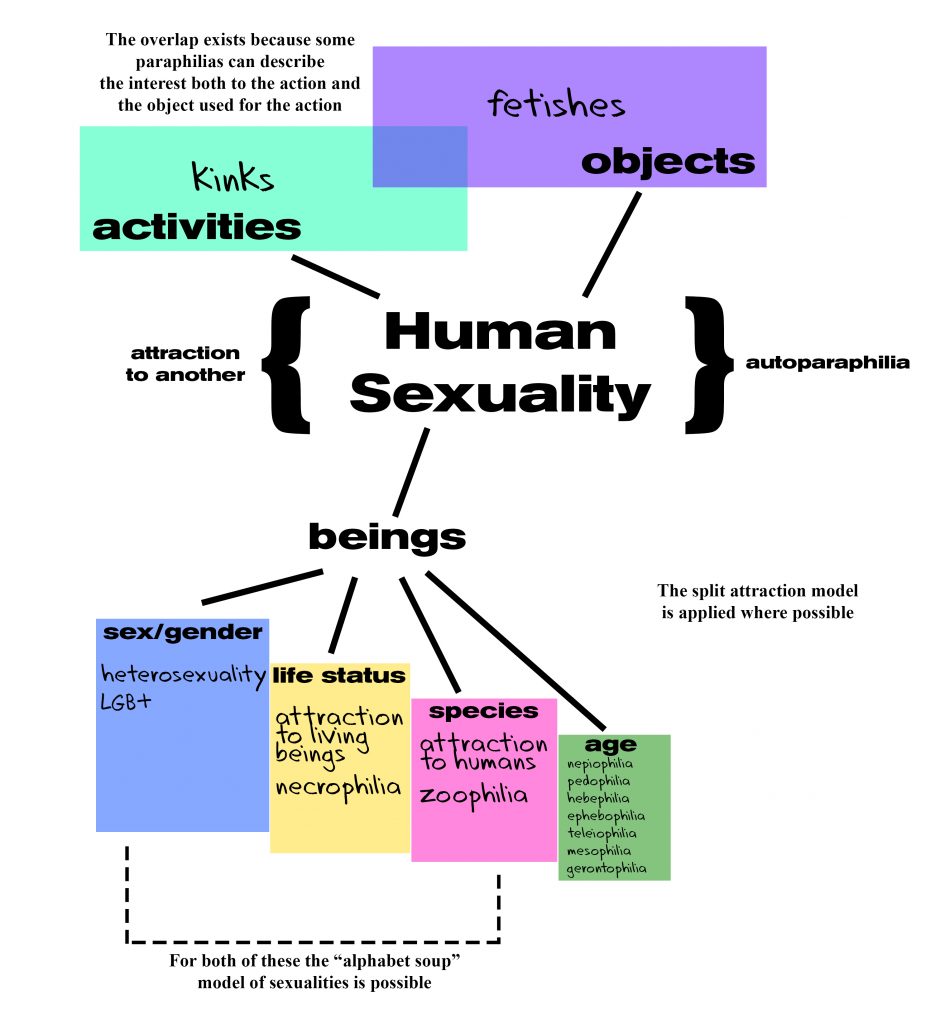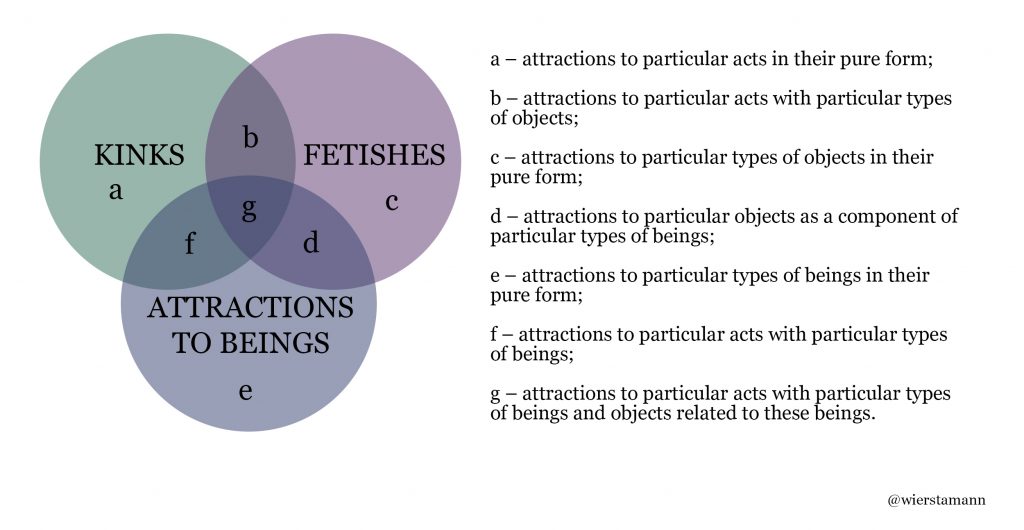This is a restored post from my WordPress. Originally posted on September 29, 2021. I still agree with everything I said here.
A few years ago I made this infographic, trying to explain to myself and to other people how attractions work and can be classified.

Soon after publishing it, I started noticing random flaws and omissions, for example, it doesn’t reflect a wider spectrum of criteria in the “beings” category, because, surely, you can single out much more important factors than the ones I listed. Also I did not think about potential overlaps between this category and the other two. So, after a lot of analysis and thinking, I present my second attempt, which is less colorful and eye-catchy, but addresses the diversity of attractions more fully.

Kinks – attractions to particular activities. A kink can manifest as an attraction to the physical part of the act or to its social implications. Include: a – attractions to particular acts in their pure form, b – attractions to particular acts with particular types of objects, f – attractions to particular acts with particular types of beings.
Fetishes – attractions to particular objects. A fetish can manifest as an attraction to the physical shape of the object or to its social implications. Include: c – attractions to particular types of objects in their pure form, b – attractions to particular acts with particular types of objects, d – attractions to particular objects as a component of particular types of beings.
An attraction to beings can manifest as an attraction to the physical properties of the being or to their mental processes and behavior. Include: e – attractions to particular types of beings in their pure form, d – attractions to particular objects as a component of particular types of beings, f – attractions to particular acts with particular types of beings.
A combination of them all (g) would include an attraction to a particular act with a particular type of a being and an object related to this being.
Let’s look at how it may be in practice. For example, you have been always attracted to barefoot children and wanted them to step on you. You are a pedophile, because the being you are attracted to is a human child. You are also a foot fetishist (podophile), because you are attracted to their feet, a non-normative body part when it comes to sexuality. Wanting to be stepped on might indicate you have a kink for being dominated, or maybe even physically hurt (masochism).
If you have several kinds of attraction within one category, you might also notice the differences between them. I have a fetish for shoes and cigarettes, but my attraction to shoes comes regardless of context, I don’t need the shoe to be worn by anyone or used in any particular manner, while I only like cigarettes as a part of an image of a “dangerous antisocial person”, which is a type of a human being I like. A cigarette, by the way, as an object someone possesses, counts as a “component” of a being, just like a body part.
This is already getting complex enough, but this isn’t even all. Enter autoparaphilia.
An autoparaphilia is defined as an attraction to oneself, but it is a little bit more complicated than that. First and foremost, you don’t have to be attracted to the features you actually have, but to the image of yourself as something else (a different age, species, gender, etc.). Second, any attraction to a situation where you are the object of your attention is under the auto umbrella too. Third, the prefix “auto” is often added to a name of an existing paraphilia to show the role reversal, e.g., biastophilia is an attraction to non-consensual sexual situations where you are the aggressor, autobiastophilia – where you are the victim. I have not yet made up how to present it well on a graphic, but I plan to make one and upload here when I figure it out.
Sometimes telling the difference between a “straightforward” attraction and an autoparaphilia is difficult. I have long been under impression that I am sexually attracted to young women’s bodies, but then found out that I actually imagine myself as them, because I am autogynephiliac. I can also be attracted to the idea of a sexual interaction with someone, and if in these fantasies I focus only on how I look and how I am perceived, I am not actually attracted to this person, but again, to myself.
Autoparaphilia creates very interesting overlaps with the categories of attractions we’ve discussed previously. You can be attracted to the image of yourself as the barefoot child stepping on someone, and also you can be attracted to yourself being stepped on by a child – and not to the child doing the stepping. “What exactly am I attracted to in this scenario” can become a routine mental exercise if you’re prone to such kinds of self analysis.
Attractions are extremely complex and multifaceted. Back when I made my original graphic, I was extremely dissatisfied with attempts to simplify a sexual orientation as exclusively a gender preference. Since then I discovered that the topic is even more complex than I imagined. Gender is just one tiny factor in considering what exactly you might find attractive. Even people who do not fit any paraphiliac identities still have an age preference and a species preference.

Leave a Reply